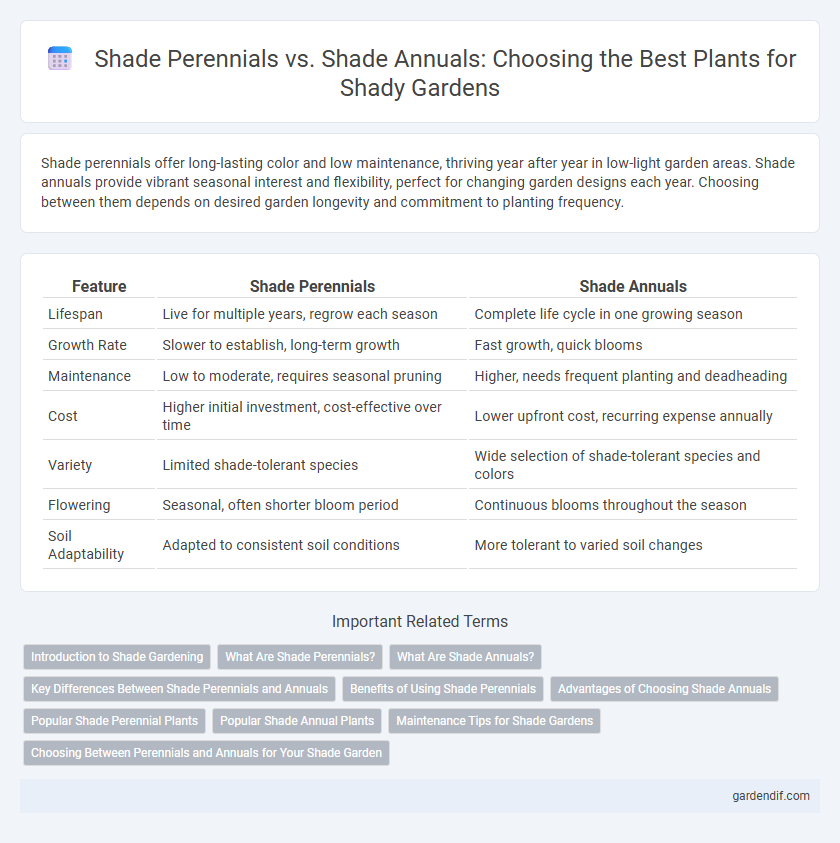
shade perennials vs shade annuals Illustration
Shade perennials offer long-lasting color and low maintenance, thriving year after year in low-light garden areas. Shade annuals provide vibrant seasonal interest and flexibility, perfect for changing garden designs each year. Choosing between them depends on desired garden longevity and commitment to planting frequency.
Table of Comparison
| Feature | Shade Perennials | Shade Annuals |
|---|---|---|
| Lifespan | Live for multiple years, regrow each season | Complete life cycle in one growing season |
| Growth Rate | Slower to establish, long-term growth | Fast growth, quick blooms |
| Maintenance | Low to moderate, requires seasonal pruning | Higher, needs frequent planting and deadheading |
| Cost | Higher initial investment, cost-effective over time | Lower upfront cost, recurring expense annually |
| Variety | Limited shade-tolerant species | Wide selection of shade-tolerant species and colors |
| Flowering | Seasonal, often shorter bloom period | Continuous blooms throughout the season |
| Soil Adaptability | Adapted to consistent soil conditions | More tolerant to varied soil changes |
Introduction to Shade Gardening
Shade perennials offer long-lasting, low-maintenance options that thrive in low-light garden areas, providing consistent color and texture year after year. Shade annuals deliver vibrant seasonal blooms and flexibility, allowing gardeners to change plantings each year for variety and immediate impact. Understanding the strengths of both helps create a diverse and visually appealing shade garden tailored to specific light conditions and maintenance preferences.
What Are Shade Perennials?
Shade perennials are plants that thrive in low-light conditions and return year after year without needing to be replanted. These hardy plants, such as hostas, astilbes, and ferns, provide consistent foliage and blooms in shaded garden areas. Unlike shade annuals, which complete their life cycle in one season, shade perennials offer long-term garden structure and require less maintenance.
What Are Shade Annuals?
Shade annuals are flowering plants that complete their life cycle within one growing season and thrive in low-light environments, making them ideal for shaded garden areas. These plants provide quick, vibrant color and can be easily replaced each year, unlike shade perennials which return season after season but may have slower growth or limited bloom duration. Common examples of shade annuals include impatiens, begonias, and coleus, which adapt well to indirect sunlight and help brighten shady spots.
Key Differences Between Shade Perennials and Annuals
Shade perennials thrive in low-light environments year after year, developing deep root systems that support long-term growth and resilience to shade conditions. Shade annuals complete their life cycle within a single growing season, providing vibrant color and quick blooms but requiring replanting each year due to their limited lifespan. The primary distinction lies in longevity and maintenance, with perennials offering sustainable shade garden structure while annuals allow for seasonal variety and immediate visual impact.
Benefits of Using Shade Perennials
Shade perennials offer long-lasting beauty and reduce the need for annual replanting, providing cost-effective landscaping solutions for shaded areas. Their deep root systems enhance soil stability and improve moisture retention, promoting a healthier garden ecosystem. Shade perennials also attract beneficial pollinators and require less maintenance compared to shade annuals, making them ideal for sustainable gardening.
Advantages of Choosing Shade Annuals
Shade annuals provide rapid seasonal color changes and allow gardeners to experiment with diverse varieties each year, enhancing garden vibrancy under low-light conditions. Their fast growth cycle maximizes visual appeal during specific seasons without long-term commitment, making them ideal for dynamic garden designs in shaded areas. These plants typically require less maintenance and adapt quickly to varying shade levels, promoting healthier growth in challenging environments.
Popular Shade Perennial Plants
Popular shade perennial plants such as hostas, ferns, and astilbes thrive in low-light garden environments, offering durable foliage and seasonal blooms that return year after year. These perennials are favored for their ability to provide consistent color and texture without replanting, reducing garden maintenance compared to shade annuals. Gardeners often choose shade perennials for their long-term resilience, adaptability to shaded areas, and ecological benefits like supporting local pollinators.
Popular Shade Annual Plants
Popular shade annual plants such as impatiens, begonias, and coleus thrive in low-light environments, providing vibrant color throughout the growing season. Unlike shade perennials, which return year after year, shade annuals offer flexibility for gardeners seeking seasonal variety and rapid growth. Their ability to flourish in shaded areas makes them ideal for brightening patios, under trees, and garden corners with limited sun exposure.
Maintenance Tips for Shade Gardens
Shade perennials require less frequent watering and thrive with annual mulching to retain moisture and suppress weeds, while shade annuals often need weekly watering and regular deadheading to promote continuous blooming. Both benefit from soil enriched with organic matter, but perennials demand less fertilizer compared to the nutrient-hungry annuals. Monitoring for pests and pruning dead foliage are essential maintenance tasks to keep shade gardens healthy and vibrant year-round.
Choosing Between Perennials and Annuals for Your Shade Garden
Shade perennials like hostas, ferns, and astilbes offer long-lasting beauty with minimal replanting, thriving in low-light environments and improving soil health over time. Shade annuals such as impatiens and begonias provide vibrant seasonal color and flexibility, allowing gardeners to change designs yearly. Selecting between perennials and annuals depends on desired garden permanence, maintenance levels, and seasonal versatility in shaded areas.
shade perennials vs shade annuals Infographic

 gardendif.com
gardendif.com